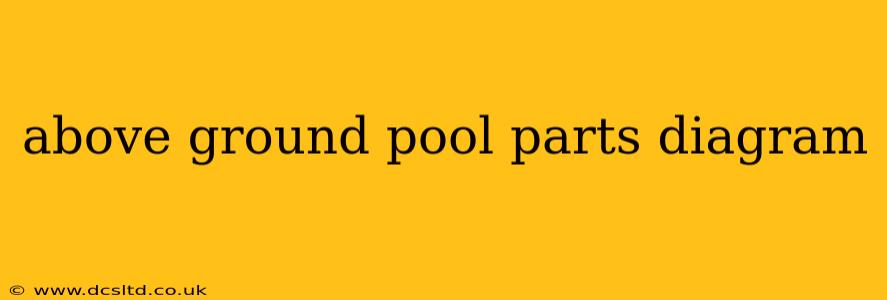Above ground pools offer a refreshing escape during the hot summer months. Understanding the various parts of your pool and their functions is crucial for proper maintenance, troubleshooting, and ensuring a safe and enjoyable swimming experience. This comprehensive guide provides a detailed look at a typical above ground pool parts diagram, explaining each component and its role.
What are the Main Components of an Above Ground Pool?
While specific components can vary depending on the manufacturer and pool type, most above ground pools share a common set of essential parts. These can be broadly categorized into the structural elements, the filtration system, and the accessories.
Structural Components:
- Pool Wall: This is the main structure, usually made of steel, resin, or aluminum. It holds the water and provides the pool's shape.
- Pool Liner: A flexible vinyl sheet that lines the interior of the pool, providing a waterproof barrier and aesthetic appeal. Liners come in various colors and patterns.
- Top Rails/Uprights: These support the pool wall and provide stability. They are typically made of metal or resin.
- Support Legs/Posts: These provide ground support for the pool, preventing collapse and ensuring stability. The number and type depend on the pool size and design.
- Coping: The top edge of the pool wall, often providing a decorative finish and a comfortable place to sit.
Filtration System:
- Pump: The heart of the filtration system, responsible for drawing water from the pool and forcing it through the filter.
- Filter: Removes debris and impurities from the pool water, keeping it clean and clear. Common types include sand, cartridge, and diatomaceous earth (DE) filters.
- Return Jets: These distribute the filtered water back into the pool, ensuring even circulation.
- Skimmer: A device that sits at the water's surface, removing debris and leaves before they sink to the bottom.
- Pipes and Fittings: A network of pipes and connectors that connect all the components of the filtration system.
Accessories (Optional but Common):
- Ladder: Provides safe access to and from the pool.
- Handrail: For added safety and stability, especially for younger or less mobile swimmers.
- Pool Cover: Protects the pool from debris, evaporation, and algae growth when not in use.
- Winter Cover: Specifically designed to protect the pool during colder months.
- Lighting: Adds ambiance and extends pool usage into the evening.
How Does an Above Ground Pool Filtration System Work?
The filtration system is crucial for maintaining water clarity and sanitation. The pump draws water from the pool, typically through the skimmer and main drain, and pushes it through the filter. The filter removes contaminants, and the clean water is then returned to the pool via the return jets. This continuous cycle keeps the water clean and safe for swimming.
What are the Different Types of Above Ground Pool Filters?
Sand Filters:
These use sand as the filtering medium. They are relatively inexpensive and easy to maintain.
Cartridge Filters:
These use replaceable filter cartridges. They offer superior filtration compared to sand filters but require regular cartridge cleaning or replacement.
Diatomaceous Earth (DE) Filters:
These utilize a fine powder called diatomaceous earth as the filtering medium. They provide the finest filtration but require more maintenance than sand or cartridge filters.
How Do I Troubleshoot Problems with My Above Ground Pool?
Troubleshooting depends on the specific issue. Common problems include:
- Cloudy water: This often indicates a problem with the filter, insufficient chemicals, or algae growth.
- Low water level: Check for leaks or excessive evaporation.
- Pump not working: Check power supply, pump impeller, and filter pressure.
- Leaks: Carefully inspect the liner, pipes, and fittings for any signs of leakage.
Addressing these issues often requires a basic understanding of your pool's components and how they function together. Referring to your pool's manual or consulting a pool professional can be helpful.
What are the Common Materials Used in Above Ground Pool Construction?
Above ground pools are typically constructed using steel, aluminum, or resin. Each material has its own advantages and disadvantages concerning durability, cost, and maintenance.
How Often Should I Clean My Above Ground Pool Filter?
The frequency of filter cleaning depends on the type of filter and pool usage. Generally, cartridge filters require cleaning every 2-4 weeks, sand filters need backwashing every 1-2 weeks, and DE filters may require cleaning even more frequently.
This comprehensive guide offers a clear understanding of the various parts within an above ground pool system. Remember that regular maintenance is key to enjoying a clean, safe, and refreshing swimming experience for years to come.
